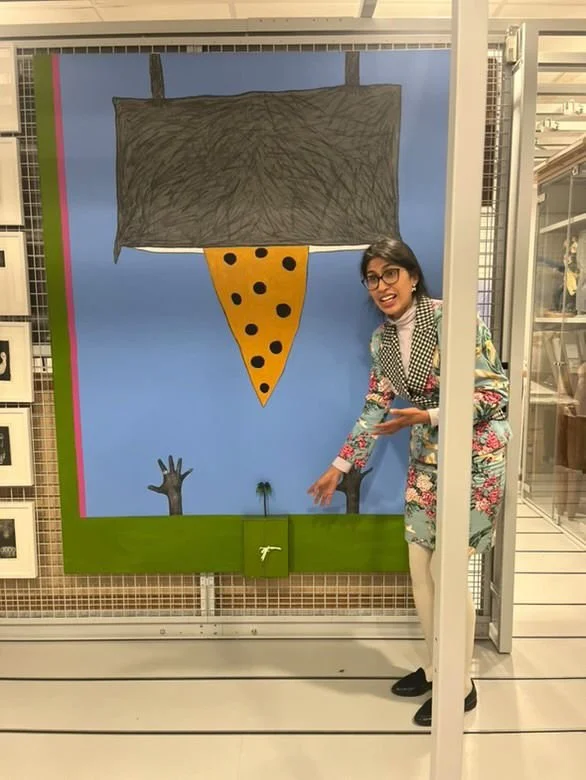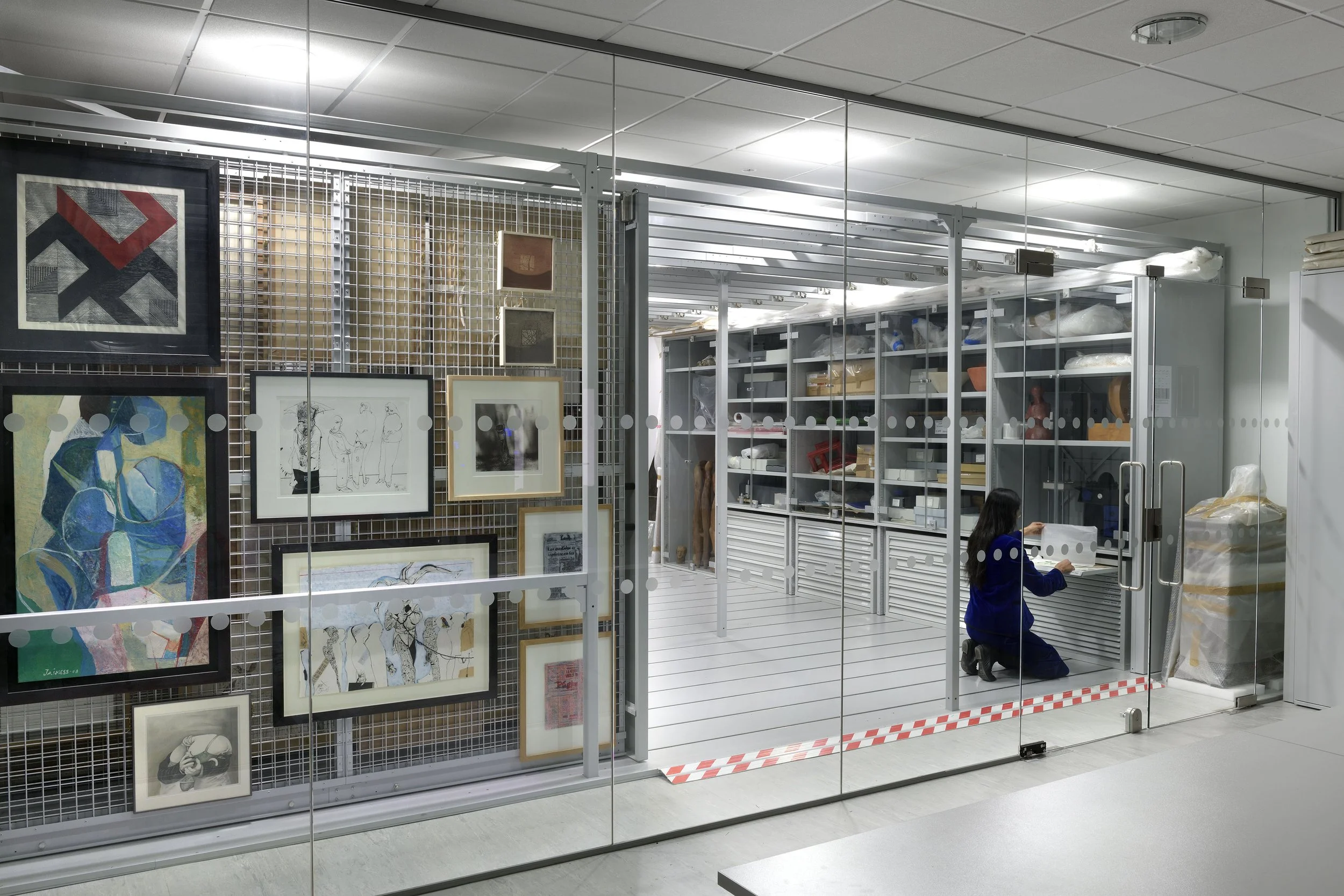Reimagining an Art Collection: Curator Gisselle Girón Casas and her approach to Latin American Art in the UK
This interview is part of the series "In the Making: Conversations on Latin American Art in the UK".
Research, Interviews and Writing by Raquel Gonzalez Eizmendiz
Curatorial & Editorial Direction by Gabriela Román González & Mónica Núñez
Gisselle Girón Casas at ESCALA’s Teaching and Reseach Space with Ofelia Rodríguez’s Préstandole un oído al pasado (1994).
Image courtesy of Dr. Lisa Blackmore
As Assistant Curator of ESCALA, the University of Essex Collection of Art from Latin America, Gisselle Girón Casas is committed to making the collection a dynamic educational and curatorial resource. Originally from Lima, Gisselle brings a dual perspective to ESCALA's curatorial practice, informed by both her experiences in Peru and the United Kingdom (UK). This dual perspective allows her to engage with Latin American visual art not only through the lens of her home country but also from the vantage point of an international art ecosystem, adding depth to her curatorial decisions. About ESCALA Collection, she states: “We are not a storage facility. We are a living collection. We want the artworks to be circulated, to breathe, to be used in learning.”
What makes ESCALA distinct from other art collections in the UK?
ESCALA is a university collection, which means our primary purpose is learning and research. We work closely with departments like Humanities, Human Rights, Languages, and Art History, and our acquisitions are made to support academic dialogue across disciplines. That is our first and most important filter. For example, we have a master’s module called Collecting Art from Latin America, and the students help select the works we acquire.[1] Students’ involvement in this selection provides a valuable opportunity for emerging curators to engage with the complex questions of representation. By actively identifying gaps, such as the underrepresentation of indigenous voices or environmental issues, students contribute to the evolution of the collection, ensuring that the stories told through the visual art are as diverse and relevant as the world we live in.
We have also made a shift in the way we acquire artworks for the collection. In the past, we acquired pieces by donation. Now, we do not do it anymore, unless there is a clear plan to turn that into a commission or remunerated project. Ethically, artists must be compensated, especially when their work is being used in classrooms by paying students. There is a power imbalance here, and we need to be conscious of that.
What kinds of impact can an acquisition have on an artist’s career?
It can be significant. When we commissioned a piece by Rebeca Romero for ESCALA’s 30th anniversary, it was the first time her work had entered a public collection. That boosted her profile, and since then, other collections have acquired her work. But even more importantly, it gave her a sense of validation, and that is part of what we want to offer as a collection.
Gisselle Girón Casas with Rebeca Romero’s Axis Mundi (2023)
The same goes for Bryan Giuseppi, another Peruvian artist based in London, from whom we commissioned the exhibition Taking a Bow/Haciendo una reverencia at the Art Exchange Gallery and will now enter the collection. Those pieces will also become part of our teaching materials, which extend their reach and relevance beyond the exhibition space.
What do you see as the major challenges for Latin American artists in the UK today?
The UK, especially post-Brexit, has become a much more hostile environment for migration. It is harder to stay, harder to access opportunities, and only artists with financial resources can afford to remain long-term. That creates a very narrow profile: most Latin American artists based here now come from elite backgrounds. And that does not reflect the richness or diversity of artistic production in Latin America.
Gisselle Girón Casas at ESCALA’s Teaching and Research Space
Image courtesy of Doug Atfield
There is also a broader issue: artists come to London, do a residency or degree, and then leave. That makes it hard to build community or continuity. And while Latin American art is getting more attention internationally, think of recent editions of ARCO, that visibility has not fully translated into the UK context.
What about the idea of a Latin American art community in the UK?
To be honest, I think the idea of a Latin American artistic community in the UK is almost a fiction. There are many of us: curators, artists, cultural professionals, but we are not connected. There are no regular gatherings, no institutional hubs, no sustained discourse. The artists we work with most closely at ESCALA are often those still based in Latin America, not here.
There are vibrant Latin American life communities in places like Peckham or Elephant and Castle, but those are not artistic communities. The art field, especially in London, is fragmented and often economically exclusive.
What gives you energy or purpose in your curatorial work?
For me, it is about building a more diverse and just cultural landscape, in Peru, in the UK, wherever I work. In Lima, I have always been committed to supporting artists from working-class backgrounds, from outside the usual hegemonic circles. Here, I am trying to do something similar, in a much more constrained environment.
And at ESCALA, even if it is small-scale, I believe in the work we are doing, acquiring works by underrepresented artists, using them in classrooms, and treating the collection as a space of engagement rather than storage. That, for me, gives life to the collection and my role in it.
[1] AR915: Collecting Art from Latin America is a module led by Dr. Lisa Blackmore and Dr. Sarah Demelo at the University of Essex.
Gisselle Girón Casas lives and works between Colchester, United Kingdom and Lima, Peru. Her curatorial practice focuses on the development of long-term projects that foster spaces of trust and intimacy, where the boundaries between curating and artistic creation become blurred. Her current research centres on contemporary Latin American practices, both from within the region and from diasporic voices, with a particular interest in queer, tender, post-digital aesthetics and the medium of artistic installation. She is currently the Assistant Curator of the Essex Collection of Art from Latin America (ESCALA) and of the University of Essex Art Collections in Colchester.




